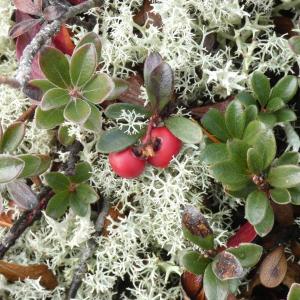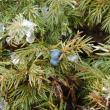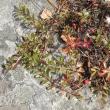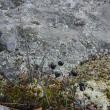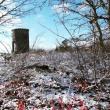Fall’s bounty of berries on Mt. Battie
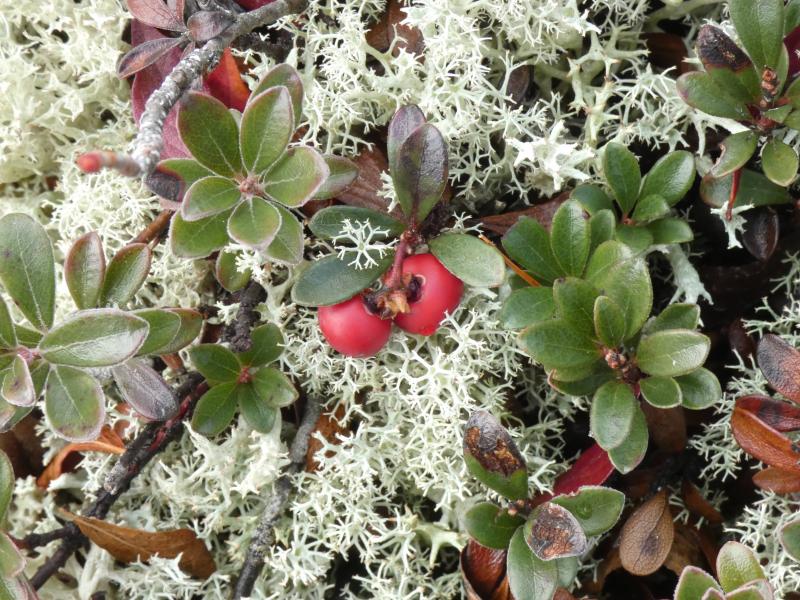 A festive bearberry and lichen tableau. (Photo courtesy Kristen Lindquist)
A festive bearberry and lichen tableau. (Photo courtesy Kristen Lindquist)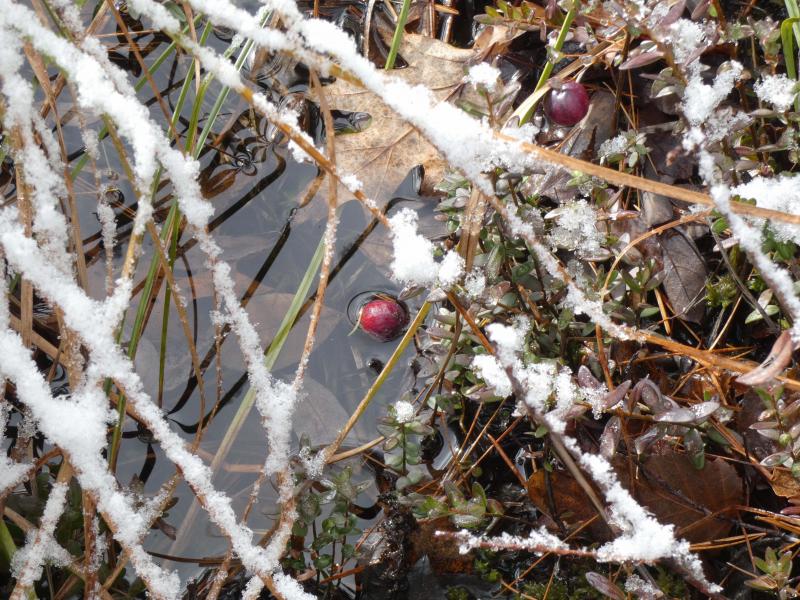 Cranberries in a small bog near the summit. (Photo courtesy Kristen Lindquist)
Cranberries in a small bog near the summit. (Photo courtesy Kristen Lindquist)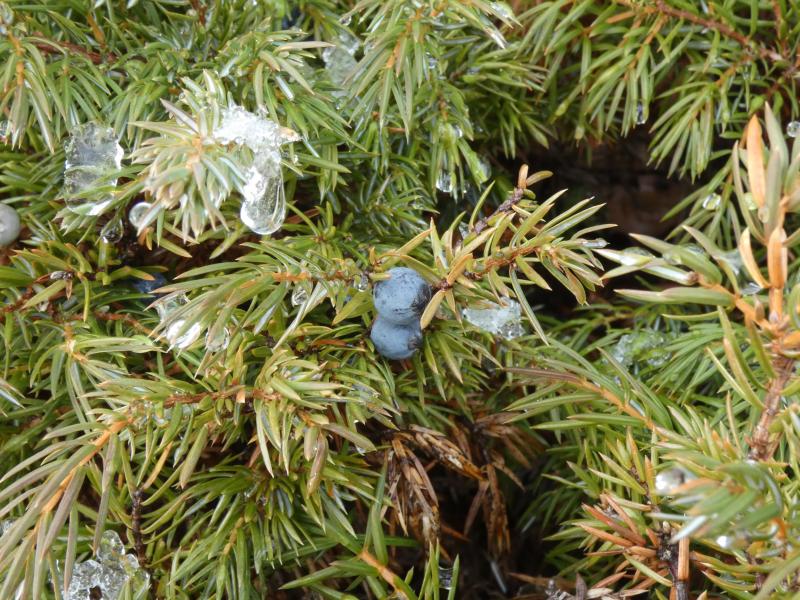 Mature juniper berries. (Photo courtesy Kristen Lindquist)
Mature juniper berries. (Photo courtesy Kristen Lindquist)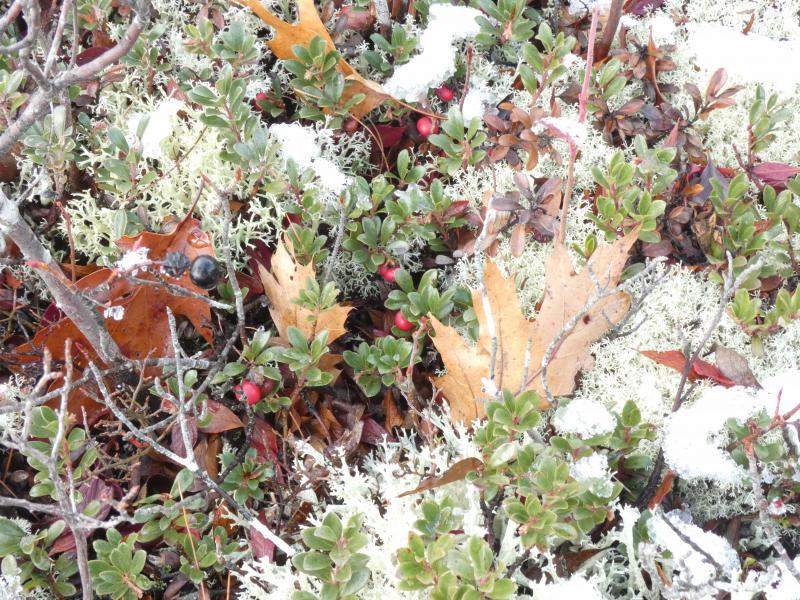 Bearberries (red) and chokeberries (black) shine amid patches of snow. (Photo courtesy Kristen Lindquist)
Bearberries (red) and chokeberries (black) shine amid patches of snow. (Photo courtesy Kristen Lindquist)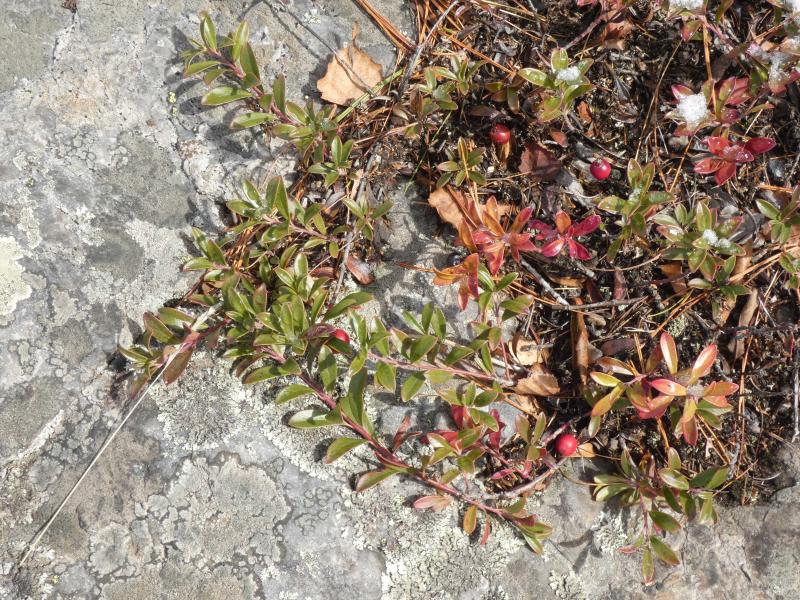 Bearberry plants trail across the mountain’s bedrock face. (Photo courtesy Kristen Lindquist)
Bearberry plants trail across the mountain’s bedrock face. (Photo courtesy Kristen Lindquist)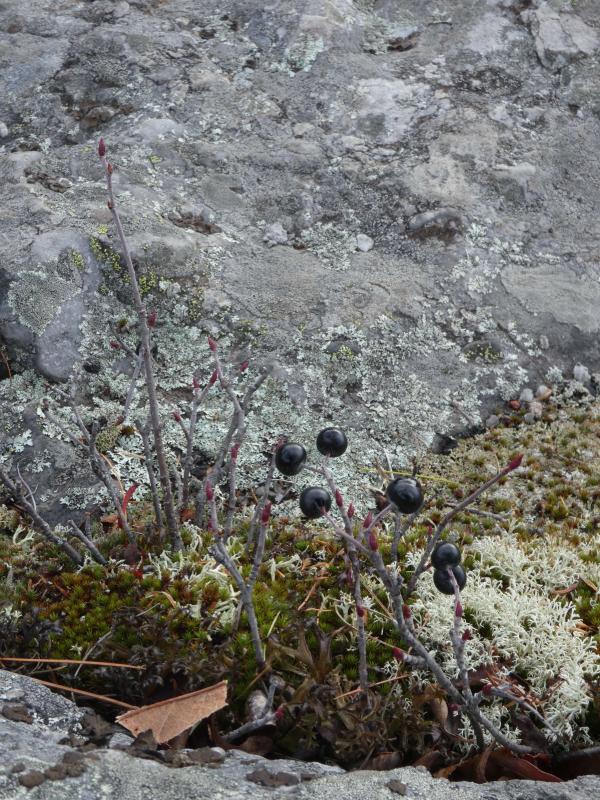 Chokeberry bushes lose their leaves before their berries. (Photo courtesy Kristen Lindquist)
Chokeberry bushes lose their leaves before their berries. (Photo courtesy Kristen Lindquist)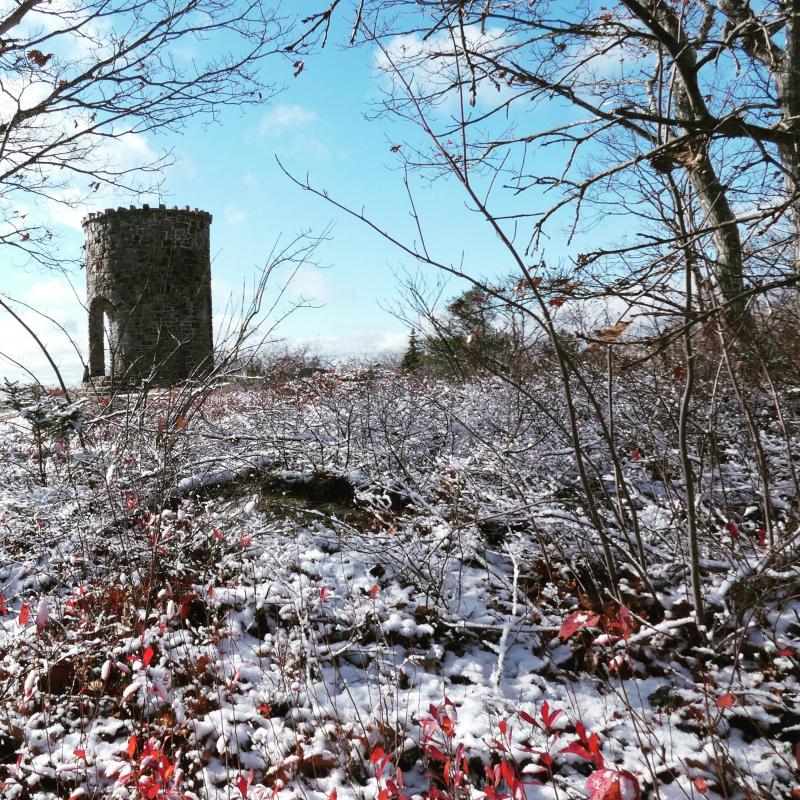 First snowfall on Mt. Battie, in early November. (Photo courtesy Kristen Lindquist)
First snowfall on Mt. Battie, in early November. (Photo courtesy Kristen Lindquist) A festive bearberry and lichen tableau. (Photo courtesy Kristen Lindquist)
A festive bearberry and lichen tableau. (Photo courtesy Kristen Lindquist)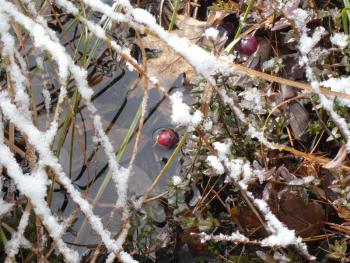 Cranberries in a small bog near the summit. (Photo courtesy Kristen Lindquist)
Cranberries in a small bog near the summit. (Photo courtesy Kristen Lindquist) Mature juniper berries. (Photo courtesy Kristen Lindquist)
Mature juniper berries. (Photo courtesy Kristen Lindquist)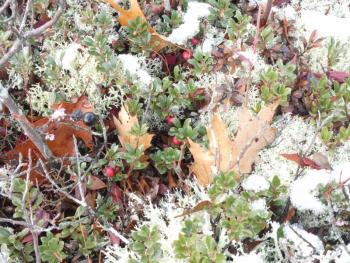 Bearberries (red) and chokeberries (black) shine amid patches of snow. (Photo courtesy Kristen Lindquist)
Bearberries (red) and chokeberries (black) shine amid patches of snow. (Photo courtesy Kristen Lindquist)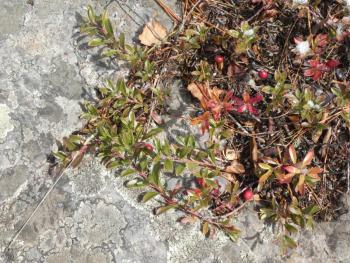 Bearberry plants trail across the mountain’s bedrock face. (Photo courtesy Kristen Lindquist)
Bearberry plants trail across the mountain’s bedrock face. (Photo courtesy Kristen Lindquist)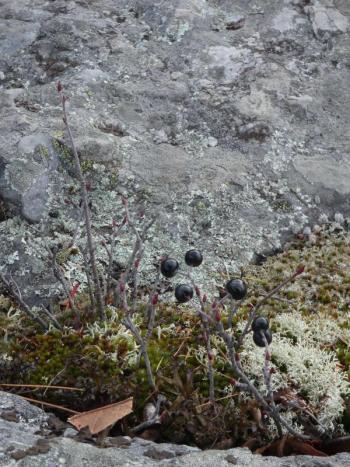 Chokeberry bushes lose their leaves before their berries. (Photo courtesy Kristen Lindquist)
Chokeberry bushes lose their leaves before their berries. (Photo courtesy Kristen Lindquist)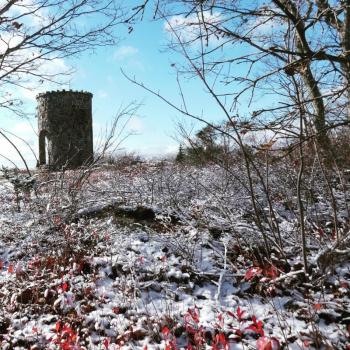 First snowfall on Mt. Battie, in early November. (Photo courtesy Kristen Lindquist)
First snowfall on Mt. Battie, in early November. (Photo courtesy Kristen Lindquist)The first snow fell recently on the summit of Mount Battie in Camden Hills State Park. Although wind had blown much of the snow off the exposed ledges when I arrived that morning, a light dusting still covered everything else. The wind picked up as I walked around. From what I could see and hear, no birds were active near the summit. I wasn’t surprised.
Then I heard them: the unmistakable ringing calls of a flock of Canada Geese, a long vee of them just coming into sight above the trees. They passed high overhead, barely visible, and something stirred deep inside me, wanting to follow. Was the feeling as simple as the fact that I too longed to be where it was warmer, where food was plentiful?
It’s no great mystery why many of the birds that nest in Maine migrate south at the end of each breeding season. It takes a lot of energy and effort to stay alive in a place that’s buried in snow and ice for months at a time. Most of the usual foods, from leaf buds to insects, are hard to come by. For many of the birds (and other beasts) that stick around through the winter, berries can be one of the keys to survival.
I always keep an eye out for berries, the wild gems of our forests. Perhaps it’s because my mother’s maiden name is Berry. If we ever designed a family coat of arms, I’d want blackberries to figure prominently. So I decided to conduct an on-the-spot, informal survey of what berries might be found on the Mt. Battie summit in November—in my way, taking a peek into the mountain’s refrigerator to see what there was left to snack on.
The berries of late fall are not the juicy, delectable fruits we associate with summer in Maine: strawberries, blueberries, raspberries, or my favorites blackberries. Those are long gone. But there are plenty of other berries to be had on our local hilltop, beginning with—appropriately, in this month of Thanksgiving—cranberries. In a pocket-sized peat bog just off the trail, I came across a patch of waterlogged cranberry bushes. A few big red berries floated in the icy water. Their size and bright color must make them enticing to birds.

They were certainly enticing to me. Large cranberries, the same species that ends up in our commercial juices and sauces, grow sweeter after a few frosts. Unfortunately, they weren’t quite there yet when I tried them. A crow, however, might find these berries delicious. And benefit, as humans do, from the potent fruit’s Vitamin C and antioxidant content.
Bearberry plants proliferate across the open ledges of the Camden Hills, and Mt. Battie is no exception. Technically considered a shrub, this low, trailing plant features attractive evergreen leaves. The berry is slightly smaller than the average cranberry, but similar in appearance. Hanging below the snow-dusted green leaves, the round red berries looked a bit like miniature Christmas balls.
While it looks alluring, I can attest that the berry is quite mealy. I wouldn’t want to have to depend on it for survival. But apparently bears enjoy them. The plant’s scientific name, Arctostaphylos uva-ursi, redundantly means “bear grapes” in two languages: Greek (the genus name) and Latin (species). Even on Mt. Battie, I always feel a little frisson when I come across bearberries, because I can’t help but also think about the potential presence of bears, and their appetites.

Sour black chokeberries hung from bare stems that poked up amid the bearberries. I also spotted wintergreen and partridgeberry, two common, berry-producing plants of the forest floor. But despite brushing snow off the leaves and rooting around, I couldn’t find any berries left on them. Birds like Ruffed Grouse love these easy-to-reach fruits. Wintergreen berries, in particular, are equally tasty to humans, although there’s not much to them besides the taste.

Ground juniper bushes grace the exposed ledges on Mt. Battie in profusion. When I inspected them, these low, prickly evergreens were laden with berries ranging in color from green (young berries) to a powdery dark blue (mature berries). The berries take two years to fully ripen. Botanically speaking, these “fruits” are actually small, fleshy cones. Juniper berries are, of course, the predominant flavor ingredient in gin, the very name of which derives from either the French or Dutch word for juniper. I’ve seen flocks of waxwings crowd together in juniper bushes, jostling for position as they popped the berries into their beaks like college kids doing shots. Perhaps for them, a juniper bush is akin to the local bar.

I was surprised not to find more bayberries on the mountaintop, though I came across several patches of their bushes. For some reason, the tiny, waxy berries that cluster along the woody stems were scarce. Maybe they’d already been picked clean by hungry birds. Bayberries are enjoyed by robins, catbirds, grouse, warblers, and many other birds. The eastern subspecies of the Yellow-rumped Warbler is, in fact, called the Myrtle Warbler because it commonly feeds on myrtle, another name for bayberry.

During the winter, the fragrant berries’ waxy coating helps preserve them, and they’re often one of the last available food sources by the time spring rolls around. This wax has also been used for centuries to make aromatic bayberry candles. When I come across a bayberry bush, I can never resist crushing a few berries or leaves between my fingers to release their familiar perfume.
And I did so then, as I prepared to head back down the mountain and out of the cold wind. Before I left, though, I looked around the snow-decorated slope one last time, recalling a flock of Bohemian Waxwings that we saw more than once last winter. Having taken a closer look, now I know what they were probably there for. I hope they, like myself, will return this winter for more.
Kristen Lindquist is an amateur naturalist and published poet who lives in her hometown of Camden.

Event Date
Address
United States

